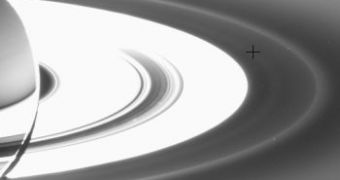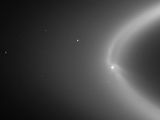The Cassini probe to Saturn has taken a set of amazing pictures of a solar eclipse. As Saturn passed in front of the Sun, the spacecraft got an eerie view of the planet's spectacular rings.
"From this viewpoint, the tiny particles of water ice that populate certain regions around Saturn brighten substantially, just like the dust on your car's windshield becomes very obvious as you drive into the sun," explained Carolyn Porco, Cassini imaging team leader.
Shielded from the direct rays coming from the Sun, the instruments managed to pick up details never seen before - even a previously unknown ring. The ring is marked with a black cross in the image below.
The ring coincides with the orbit of two of Saturn's moons Janus and Epimetheus. These two moons share approximately the same orbit - in fact, they trade orbits: each four years the moon, closer to Saturn, goes further away from the planet and the one further away gets closer to the planet. The moons seem to form a stable system. (As far as we currently know, this arrangement is unique in the solar system.) The fact that the new ring shares the same orbit with them is probably not coincidental.
"This torus of fine particles, similar to those associated with other bodies throughout the solar system, is likely caused by meteoroid impacts onto Janus and Epimetheus that release small particles into Saturn orbit," Porco said.
Cassini also obtained an amazing image of the moon Enceladus ejecting jets of ice into space. Scientists think that Enceladus is covered with ice but that liquid water might exist beneath the surface. Saturn's proximity keeps the moon active as the planet's large gravitational pull offers a constant influx of energy to the moon (the phenomenon is called tidal heating). It seems that Saturn's rings are there because they are constantly replenished by the ejection of new materials from its moons.
"Even more startling are long tendrils of fine icy particles in the vicinity of Enceladus, extending tens of thousands of kilometers fore and aft of the moon," said Porco. "These are very likely the supply lanes of fine icy particles being ejected from the south polar geysers of Enceladus and into the E ring... planetary interchange in action."
Finally, the biggest enticement of this solar eclipse seen from Saturn was an image of our planet taken from very far away - Earth as a tiny blue orb (see article).
The Cassini-Huygens mission is a cooperative project of NASA, the European Space Agency and the Italian Space Agency. The Cassini spacecraft has been orbiting Saturn for the past two years.

 14 DAY TRIAL //
14 DAY TRIAL // 
